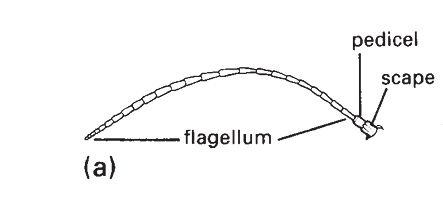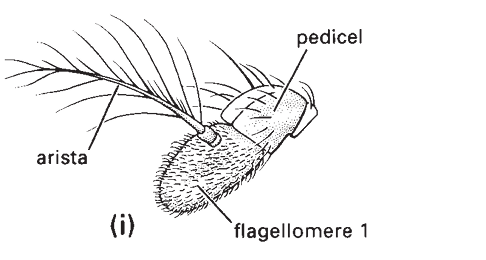
Cephalic sensory structures
 المؤلف:
P.J. Gullan and P.S. Cranston
المؤلف:
P.J. Gullan and P.S. Cranston
 المصدر:
The Insect an outline of Entomology
المصدر:
The Insect an outline of Entomology
 الجزء والصفحة:
5th E , P43-45
الجزء والصفحة:
5th E , P43-45
 2025-02-05
2025-02-05
 934
934
The most obvious sensory structures of insects are on the head. Most adults and many nymphs have compound eyes dorsolaterally on the head (prob ably derived from segment 1 of the head) and three ocelli on the vertex of the head. The median, or anterior, ocellus lies on the frons and is formed from a fused pair of ocelli; the two lateral ocelli are located more posteriorly on the head. The only visual structures of larval insects are stemmata (singular: stemma), or simple eyes, positioned laterally on the head, either singly or in clusters.
Antennae are mobile ,segmented ,paired appendages. Primitively, they appear to be eight-segmented in nymphs and adults, but often there are numerous subdivisions, sometimes called antennomeres. The entire antenna typically has three main divisions (Fig. 1): the first segment, or scape, generally is larger than the other segments and is the basal stalk; the second segment, or pedicel ,nearly always contains a sensory organ known as Johnston’s organ, which responds to movement of the distal part of the antenna relative to the pedicel; the remainder of the antenna, called the flagellum, is often filamentous and multisegmented(with many flagellomeres),but may be reduced or variously modified (Fig. 2).

fig1. filiform– linear and slender

fig2. aristate– with enlarged third segment bearing a bristle.
The antennae are reduced or almost absent in some larval insects. Numerous sensory organs, or sensilla (singular: sensillum), in the form of hairs, pegs, pits or cones, occur on antennae and function as chemoreceptors, mechanoreceptors, thermoreceptors and hygroreceptors . Antennae of male insects may be more elaborate than those of the corresponding females, increasing the surface area available for detecting female sex pheromones . The mouthparts, other than the mandibles, are well endowed with chemoreceptors and tactile setae.
 الاكثر قراءة في الحشرات
الاكثر قراءة في الحشرات
 اخر الاخبار
اخر الاخبار
اخبار العتبة العباسية المقدسة


